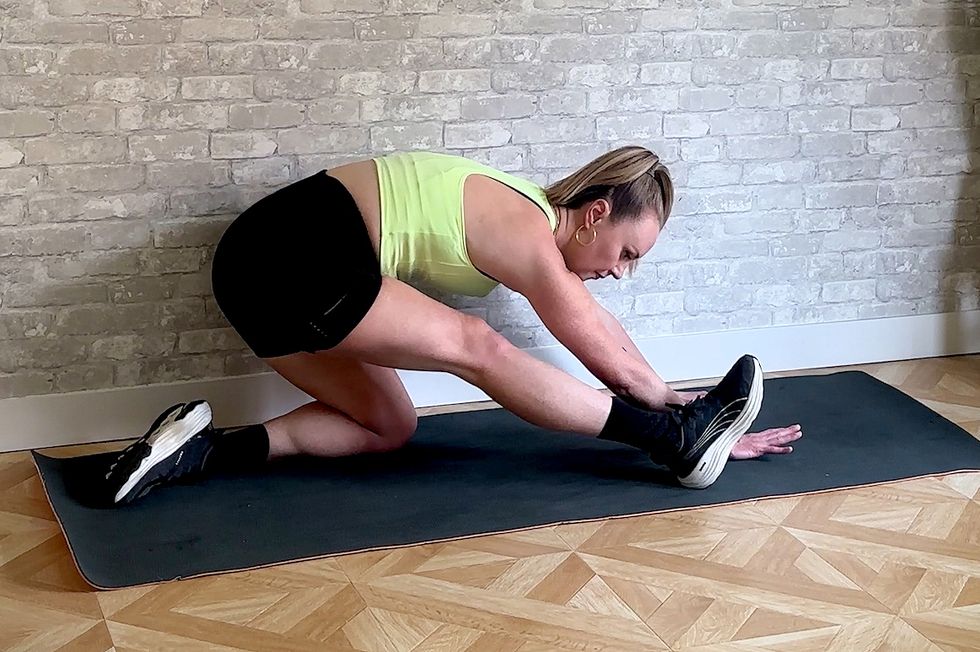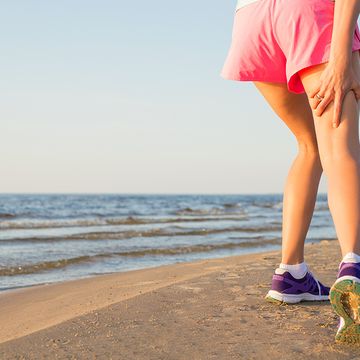Running can bring on a few aches when you start clocking miles more regularly, but it should never be a pain in the butt—quite literally.
While buttocks pain can plague many runners—and it often signals a potential injury known as piriformis syndrome—it’s not something to ignore. To help you avoid this ache and stay running pain-free, here’s everything to know about pain in the butt cheek while you run, including the best exercises to address it.
What causes pain in the butt cheek?
Although there are many things that can contribute to pain in the right or left butt cheek, which are made up of your glute muscles Running Repeat for 10 reps. Then switch sides. Do 3 sets.
The piriformis is a powerful, small muscle that sits deep behind the glute and is responsible for external rotation of the hip joint when the hip is extended. The sciatic nerve typically passes under the piriformis, but it sometimes passes over the muscle or even through it (depending on the person). When the nerve gets irritated, either through repetitive activities like running or prolonged sitting, this causes a deep, dull pain.
“The sciatic nerve is a big bundle of nerves that supplies motor and sensory function from the hips all the way down to the toes,” says Blake Dircksen, D.P.T., C.S.C.S., doctor of physical therapy and owner of Backroads Endurance Company in New York City. “So when the nerve is chronically compressed, you may experience symptoms all the way down the leg.”
In a perfect world, the sciatic nerve is able to slide, glide, and bend with movements such as hip flexion and rotation. When it’s compressed, that mobility is compromised.
at the track when that zing kicks in? Slow down, and take some.
Common symptoms of sciatica include a deep burning or cramping in the glute or posterior thigh, tingling or a shooting pain down the leg, and discomfort with sitting on hard surfaces. The good news is that there are a number of things that you can do to alleviate the pain.
How can you relieve the pain in my butt cheek?
In the short term, mix up your activity levels. So, if you feel sharp pain in your buttocks when sitting or running—do the opposite. On a plane? Get up and walk around. Hitting a speed workout at the track when that zing kicks in? Slow down, and take some time off.
Small tweaks, such as making an effort to minimize sitting time or using a soft cushion when sitting on hard surfaces and removing wallets from the back pocket can make a major difference, according to Dircksen.
DAA Industry Opt Out gait, as excessive overpronation, or the inward movement of the foot when you land, has been shown to contribute to the issue, says exercise physiologist Susan Paul.
The piriformis itself can cause butt cheek pain when it’s overworked and fatigued, which typically happens after the big muscles that drive running motion fatigue first—that is often the gluteus medius—which is why it’s important to strengthen those glute muscles.
In the long term, it’s all about stretching and strengthening the piriformis and the surrounding muscles to help reduce muscle tension.
Exercises to Help Address Buttocks Pain
Here, Dircksen outlines techniques to counteracting piriformis syndrome. Try them out to relieve the nagging pain in your butt cheek.
1. Sciatic Nerve Flossing
- Sit on the edge of a chair or bench, feet on the floor. The butt cheek with the pain hangs off the edge.
- Bend the leg with the pain and draw the toes behind you as you look up and back toward the ceiling. It’s okay to feel a slight amount of discomfort here.
- Next, straighten that knee and extend the leg out in front of you as you flex the toes and tuck chin to chest.
- Continue leaning forward and back for 30 seconds.
2. Figure-Four Foam Rolling
- Sit on a foam roller.
- Reach left arm back and place it a few inches on the floor. Cross left ankle over right knee, creating a figure-four position.
- Rotate top hip to lift knee, keeping feet together.
- Sit up straight then lean back, placing hands lightly on the floor behind hips. Hold for 2 seconds.
- Repeat on opposite side.
3. Dynamic Hamstring Stretch
- Start in a runner’s lunge with right foot forward, both hands on the floor framing front foot.
- A Part of Hearst Digital Media.
- Your glutes do a lot of work when you run. Heres how to keep them strong and pain-free.
- Continue leaning forward and back for 30 seconds.
- Then repeat on other leg.
4. 90/90 External Rotation Stretch
- Sit on the floor with right leg bent at a 90-degree angle in front of torso, right shin parallel to shoulders.
- Position left leg to left side, with knee bent at a 90-degree angle and inside of leg on floor. Right heel and left knee should line up.
- Place hands lightly on the floor on both sides of right leg.
- Gently lean shoulders forward over right leg without rounding back. Hold for 2 seconds.
- Sit up straight then lean back, placing hands lightly on the floor behind hips. Hold for 2 seconds.
- Continue walking forward to edge of mat.
5. Clamshell
- Lie on side with mini band around thighs. Hips and knees bent about 90 degrees.
- and other health and fitness publications.
- Slowly lower back down.
- Repeat for 10 reps. Then switch sides. Do 3 sets.
6. Monster Walk
- Stand with feet hip-width apart, band around ankles.
- Send hips down and back into a shallow squat.
- With tension on the band, step forward with right foot.
- Moves to Help Ease Sciatica Aches.
- Continue walking forward to edge of mat.
- Then walk backward. Maintain tension on the band the entire time.
- Best Hydration Packs.

Emily Abbate is a freelance writer, certified fitness trainer, and host of the podcast Hurdle. You can find her work in GQ, Shape, Runner’s World, Gently lean shoulders forward over right leg without rounding back. Hold for 2 seconds.
John Vasudevan, M.D. is an associate professor at the University of Pennsylvania. He is board-certified in Physical Medicine & Rehabilitation and Sports Medicine. He is a Team Physician for UPenn Athletics and medical director of the Broad Street Run and Philadelphia Distance Run, and previously for the Rock 'n' Roll Half-Marathon and Tri-Rock Triathlon in Philadelphia. He is a director of the running and endurance Sports Medicine Program at Penn Medicine. Dr. Vasudevan provides non-operative management of musculoskeletal conditions affecting athletes and active individuals of all levels, and combines injury rehabilitation with injury prevention. He utilizes a variety of ultrasound-guided procedures and regenerative approaches such as platelet-rich plasma and percutaneous ultrasonic tenotomy. He sees patients at the Penn Medicine and the Philadelphia Veterans Administration hospital. Dr. Vasudevan attended medical school at the University of Wisconsin School of Medicine and Public Health in Madison. After his Transitional Year in Tucson, Arizona, he went to residency in PM&R at Thomas Jefferson University in Philadelphia and onwards to Stanford University for his fellowship in Sports Medicine. He has been in practice at the University of Pennsylvania since 2012.








